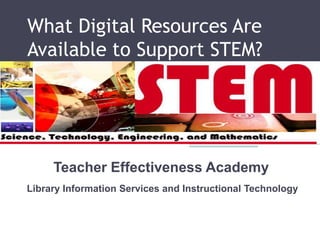
Session3a
- 1. What Digital Resources Are Available to Support STEM? Teacher Effectiveness Academy Library Information Services and Instructional Technology
- 2. Participant Outcomes Participants will: • Increase awareness of how to access digital content that supports the Common Core State Standards for ELA and Literacy in History/Social Studies, Science, and Technical Subjects. • Cite a least two ways to utilize trans-disciplinary BCPS Online Research Models to engage students in STEM investigations, research, inquiry, and problem solving.
- 3. Why focus on digital content now? • The CCSS for English Language Arts and Literacy calls for students to be able to: ▫ Read texts of increasing complexity; ▫ Read and use exposition, including literary nonfiction; ▫ Read a wider range of reading materials; ▫ And use reading, writing, speaking and listening, language skills and strategies across all subject areas • in order to be prepared for college and the workforce.
- 4. Increase in Text Complexity: Grades 2-3 Lexile Ranges Aligned to CCR Expectations Old Lexile Ranges Typical 450 - 450 - 790 Reader Lexile Scores 725 140 - 700
- 5. Increase in Text Complexity: Grades 4 - 5 Lexile Ranges Aligned to CCR Expectations Old Lexile Ranges Typical 770 - 645 - Reader 980 Lexile Scores 845 445 - 910
- 6. Where can you find a wide range of expository texts (including literary nonfiction) of increasing complexity about all subjects? Click on the image to learn more.
- 7. What elementary digital content is available? Many MORE than we can share with you today!
- 8. Today we will focus on . . .
- 9. Click on the image to learn more about SIRS Discoverer
- 12. Why focus on digital content now? • The CCSS for English Language Arts and Literacy calls for students to be able to: ▫ Read texts of increasing complexity; ▫ Read and use exposition, including literary nonfiction; ▫ Read a wider range of reading materials; ▫ And use reading, writing, speaking and listening, language skills and strategies across all subject areas; • in order to be prepared for college and the workforce.
- 13. Online Research Models Click on the image to learn more.
- 14. Example of Elementary Online Research Model: Schoolyard Habitat Click on the image to learn more.
- 15. Review objectives • How has your awareness of how to access digital content to support the Common Core State Standards for ELA and Literacy in History/Social Studies, Science, and Technical Subjects increased? • Cite at least two ways to utilize trans-disciplinary BCPS Online Research Models to engage students in STEM investigations, research, inquiry, and problem solving.
Notes de l'éditeur
- Welcome to today’s Educator Effectiveness Training on the digital resources that are available to support STEM. As is true of all the trainings, you may choose to present this training as a 30 minute session to your school staff, or (based on your evaluation of what your teachers already know and are able to do) you may choose to use the Extension activities built-in to the training. We strongly encourage you to co-present the digital resources training with your library media specialist as he or she has received extensive training on each of the digital resources.
- Soon after the CCSS were adopted in June, teams of educators from across that state began working on a gap analysis by comparing the State Curriculum Standards with the Common Core State Standards. In English Language Arts, there were several key “take-aways”: Text complexity must be evaluated and students must read more complex texts in all subject areas. There must be an emphasis on reading informational texts.
- SIRS Discoverer contains a wide range of expository texts (including literary nonfiction) of increasing complexity about all subjects. Click the SIRS Discoverer icon to start the screen cast.
- How does BrainPop provide access to a wide range of expository texts (including literary nonfiction) of increasing complexity about all subjects? It’s simple; turn on Closed Captioning. Click the BrainPop icon to begin the screen cast.
- Defined STEM is a collection of digital resources designed to promote effective and relevant connections between STEM classroom content and STEM career pathways, thus providing learning opportunities for students. Defined STEM provides teachers a resource where they can access highly effective media content, literacy tasks, and related support materials – all aligned to the Common Core English Language Arts and Literacy in Science and Technical Subjects. These resources and materials allow teachers to prepare students for entry into the 21st century global market place, where students must excel in science, math, technology and engineering to become a contributor to the marketplace. Click on the Defined STEM icon to view the screen cast.
- Soon after the CCSS were adopted in June, teams of educators from across that state began working on a gap analysis by comparing the State Curriculum Standards with the Common Core State Standards. In English Language Arts, there were several key “take-aways”: Text complexity must be evaluated and students must read more complex texts in all subject areas. There must be an emphasis on reading informational texts.
- The Online Research Models (ORM), developed by Baltimore County Public Schools, represent an exciting way to guide student research toward higher-level thinking that fully utilizes digital resources. The research models will help teachers meet the CCSS’s increased demand for research by providing the scaffolding and a key collaborator: the school’s library media specialist. The ORM are designed as web pages that present students with a clear research structure, including a research scenario, a learning task, rubrics and scoring tools, directions for use of various media resources, links to useful web sites, creation of a product or presentation, and reflection. Students who use the self-guided online research lessons are challenged to employ thoughtful reading, analysis, evaluation, and synthesis of information to create answers, not just find them.
- Click the Schoolyard Habitat icon to view the screen cast.